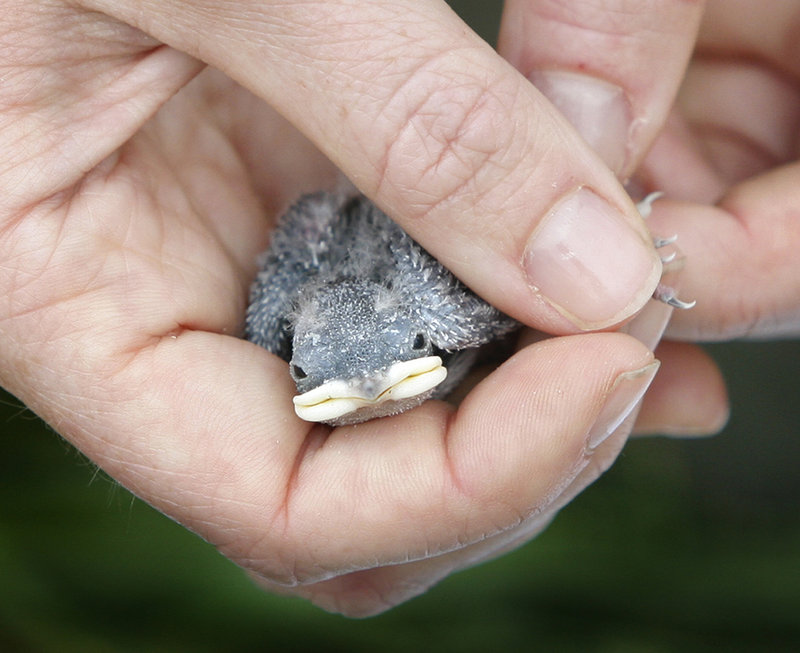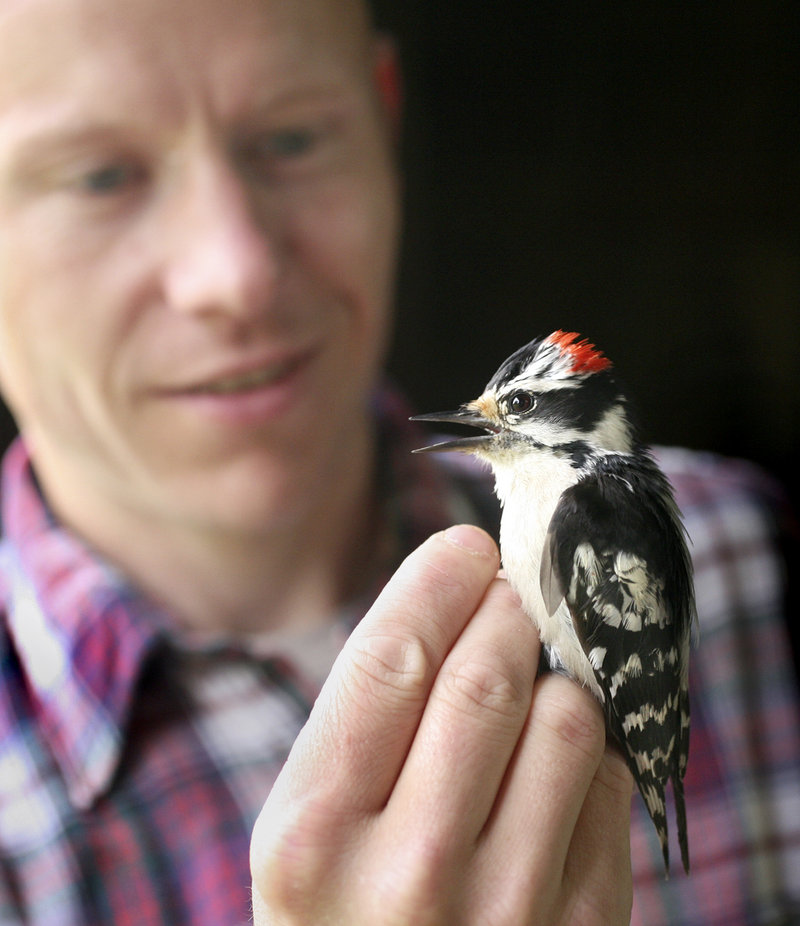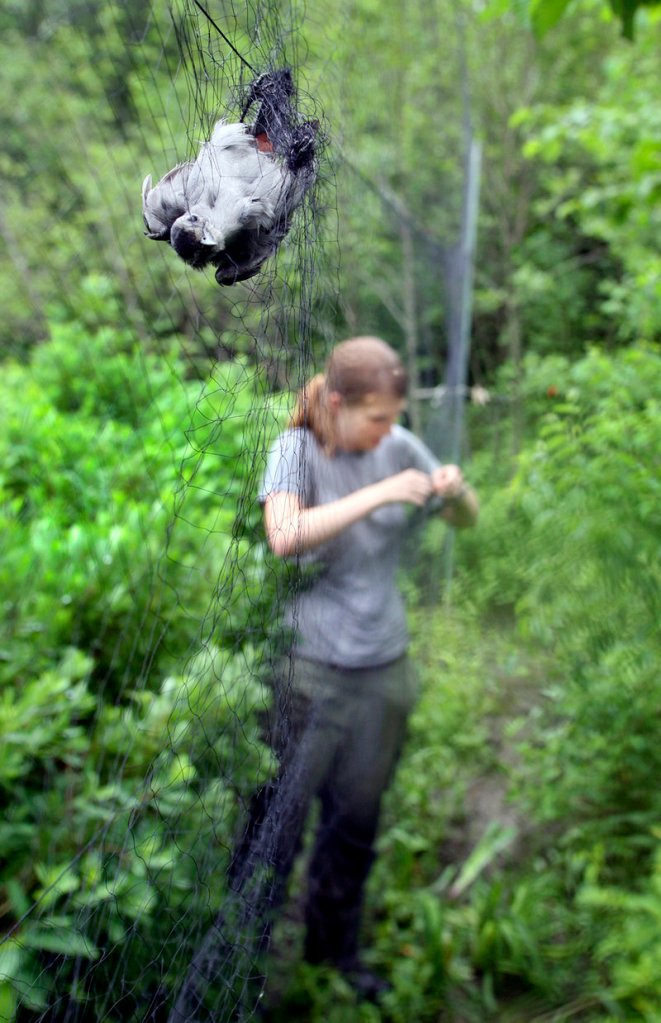GORHAM – In the past year, the BioDiversity Research Institute has tripled its staff, quintupled its revenues and enlarged its network of scientific studies after the federal government hired BRI to help determine the impacts of last year’s Deepwater Horizon oil spill on birds in the Gulf of Mexico.
Now the organization known for its scientific research on environmental threats to birds and other wildlife is turning its sights on the Gulf of Maine with a number of projects aimed at assessing the impact of renewable energy infrastructures such as wind turbines on migratory birds.
“We gather neutral science and give it to others to make decisions,” said Executive Director David Evers.
BRI plans to announce several new ventures Tuesday along with a redesigned website and logo.
The institute is best known in Maine for its pioneering work with web cameras aimed at bald eagle and peregrine falcon nests in Maine. An eagle cam’s daily audience hit a high of 60,000 at one point. But in the past year, the 13-year-old institute housed in a white farmhouse across from the University of Southern Maine’s Gorham campus has burst out as a major player on the environmental research scene.
Revenue jumped from just under $2 million in 2009, after four years of double-digit growth, to more than $11 million last year.
The staff of full-time and seasonal researchers and administrators has grown from 25 to just under 80, with 50 of those full time.
Bursting at the seams in its 5,000-square-foot building on Flaggy Meadow Road, the institute has spilled over to another 7,000-square-foot farmhouse at 652 Main St. Now the organization is on the lookout for larger quarters to house its burgeoning operations.
“We see that rate of growth continuing,” said Wing Goodale, deputy director.
The institute’s roots date to the early 1990s, when then-graduate student Evers was studying the effects of toxic methylmercury on wildlife.
Mercury released by burning coal goes into the atmosphere, then settles on soil and the bottom of bodies of water where bacteria converts it to a toxic form called methylmercury. In that form, it accumulates and gets concentrated as it moves through the food chain.
Loons are ideal bio-indicators of the presence of mercury in the environment because they are large, live up to 30 years and are highly territorial. Testing for the presence of mercury in a blood sample from a loon will show how much toxic mercury is present where the loon lives.
But first Evers had to figure out how to capture the notoriously elusive bird, a symbol of the northern wilds known for its haunting yodel. Playing upon the loon’s strong parenting response, Evers found out he could lure adult loons right up to his boat at night by imitating a chirping loon chick.
Hiding behind blinding lights, Evers could then scoop up the bird with a net and take a blood sample and band it.
Evers’ research eventually led him to Maine, where he opened BRI in 1998.
The institute is one of a few nonprofit independent scientific research organizations in the country with a focus on birds, similar to PRBO Conservation Science in Point Reyes, Calif., and Manomet Center for Conservation Sciences in Plymouth, Mass., said Rebecca Holberton, a University of Maine associate professor of biology.
“BRI’s work with mercury has added a huge resource,” said Holberton, who is one of the many scientists who collaborate with BRI on migratory bird research.
At any one time, BRI is involved with 80 to 100 research projects around the world, including about a dozen in Maine. One is the River Point Conservation Area in Falmouth.
BRI researchers Patrick Keenan and Allyson Jackson are spending the season studying the migratory birds that pass through the area and the breeding success of the resident black-capped chicadee, tree swallow and house wren population.
Now in its first year, the Falmouth study will continue for years to give scientists a better idea of the movement of birds along the Maine coast.
With the Gulf of Mexico work winding down, the institute has gotten more involved in worldwide mercury research for the United Nations, which is trying to locate the world’s mercury hot spots as it works on a global mercury treaty for 2013.
BRI scientists are monitoring yellow-billed loons in Russia as part of that effort.
Evers said the good news about mercury is that levels are decreasing in the United States, thanks to environmental regulations. But levels are increasing in other parts of the world, such as China.
Evers will outline BRI’s work in the Gulf of Mexico to the public at 4 p.m. Tuesday on the seventh floor of Glickman Library at USM’s Portland campus.
He also will unveil a number of new initiatives, such as public excursions to the tropics to work with scientists in the field, and a new internship program.
The newly redesigned website and logo should be available online at www.briloon.org on Tuesday.
Staff Writer Beth Quimby can be contacted at 791-6363 or at:
bquimby@pressherald.com
Send questions/comments to the editors.






Success. Please wait for the page to reload. If the page does not reload within 5 seconds, please refresh the page.
Enter your email and password to access comments.
Hi, to comment on stories you must . This profile is in addition to your subscription and website login.
Already have a commenting profile? .
Invalid username/password.
Please check your email to confirm and complete your registration.
Only subscribers are eligible to post comments. Please subscribe or login first for digital access. Here’s why.
Use the form below to reset your password. When you've submitted your account email, we will send an email with a reset code.